Bali Island in Indonesia is known for its beauty, its laid-back attitude, and its scenic beaches. People from India may not notice its terraced rice fields, but what if I told you that these rice fields along with the Water Temples of Bali are part of the cultural landscape of the place? This is the same landscape that has the UNESCO World Heritage Site recognition.

I have many reasons to visit Bali – the big one was to cover the UNESCO World Heritage site. As a heritage site, it is baffling. The UNESCO site says it is the cultural landscape and the Subak system that is the heritage. It mentions one temple – Taman Ayun, which is a royal one but no other temples are mentioned anywhere. However, when I visited the temples of Bali like Tirtha Empul, I realized it is also a part of UNESCO Listing. I understand it is the water management that is key, so I am including all those water temples of Bali that I think form the UNESCO World Heritage – Cultural Landscape of the place.
Hindu Temples in Bali
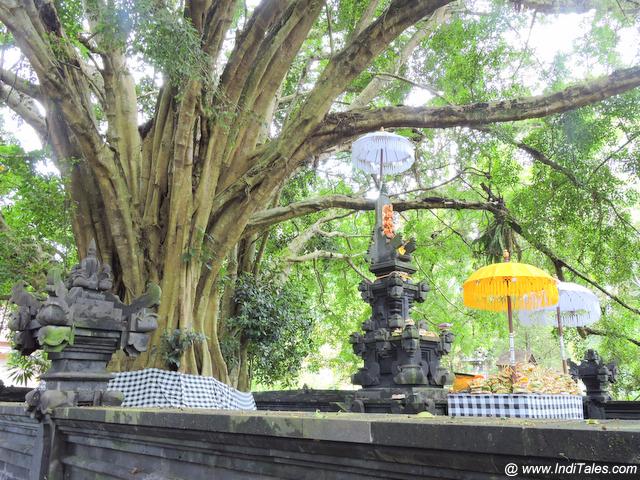
Bali a Hindu island, with thousands of Hindu temples has a lot to connect for us Indians. You see more Hindu deities in public spaces than you can ever see in India. The road names are very Indian, many of them from the epics – Bhim and Hanuman being the favorite characters. Ramayana performances leave you enchanted. I still wonder how those artists create music without any musical instruments.
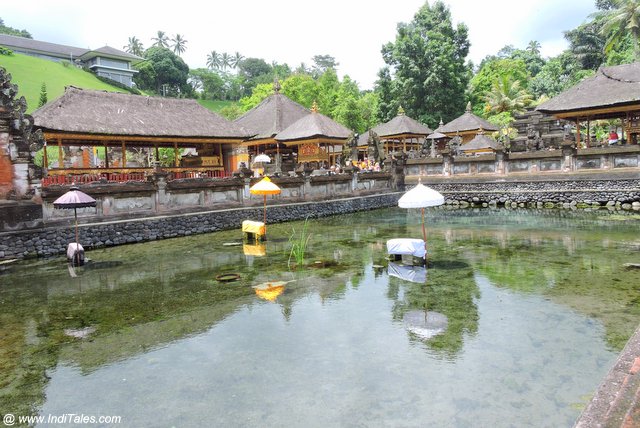
Having said that, these are very different from the Indian temples – there are no images inside. There are platforms on which offerings are made. Non-Hindus are not allowed in most of them – at least not inside the temple. Even when I told them I am a Hindu, I was not allowed unless I wore the Sarong and the belt. Most places I could not enter and wherever I could – I was looked upon suspiciously.
Subak System – Traditional Balinese Water Management

Tri-hit-Karna – a word that comes from 3 Sanskrit words is the basis of the Subak system. Tri means three, hit being welfare or well-being and Karna – doing. This is a philosophy that would benefit all three – you, your neighbor, and the environment. It basically deals with the fair distribution of water in a way that you and your fields benefit from it without damaging the environment. It ensures the equitable distribution of natural resources, water being key natural resources in a way that the whole community gets the benefit of it.
Subak system includes the planning of rice plantation – as you know rice is a water-hungry crop.
Any violators of the Subak system are dealt with in temples. It is a kind of community control system for a larger good. A detailed reading of the Subak system on this Website revealed how well-structured this system is. I gather that it is not just a community system but it also includes social and cultural norms. Farmers pray to the Devi for fertility and abundance together.
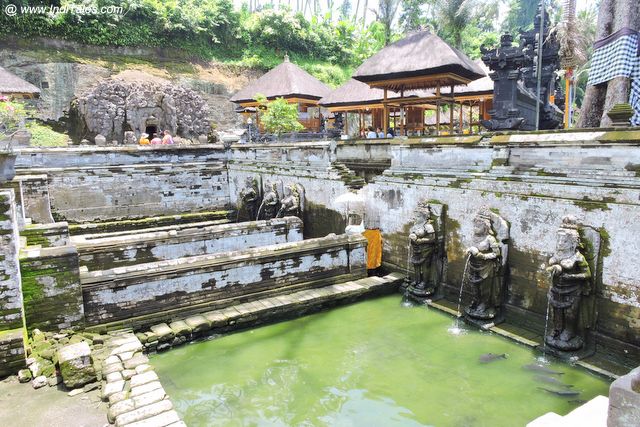
Subak Water Temple
Each Subak has a water temple associated with it. There is a Subak museum in the town that showcases how the Subak System works.
Subak system includes forests, terraced rice fields, canals, or any other water transportation tools and temples. There are more than 1000 such Subaks in the region with anywhere from 50-400 farmers in each of them.
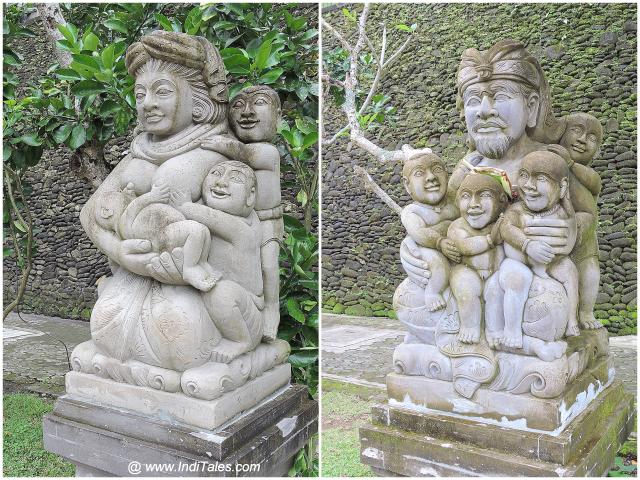
Water Temples of Bali
Subak System is inscribed as the UNESCO World Heritage and includes the following water temples of Bali:
- Pura Ulun Danu Batur on the Banks of Lake Batur – which is considered the original source of all water here.
- Subak Landscape of Pakerisan Watershed – the oldest known irrigation system in the region.
- Subak Landscape of Catur Angga Baturkaru – a 10th CE inscription talks about its Subak System.
- Pura Taman Ayun – The Royal Temple with the largest Subak System.
However, when I visited the Tirtha Empul – I saw a UNESCO inscription there too.
Let me walk you through the water temples of Bali that make the culture a rich landscape.
Pura Taman Ayun – Biggest of the Water Temples of Bali
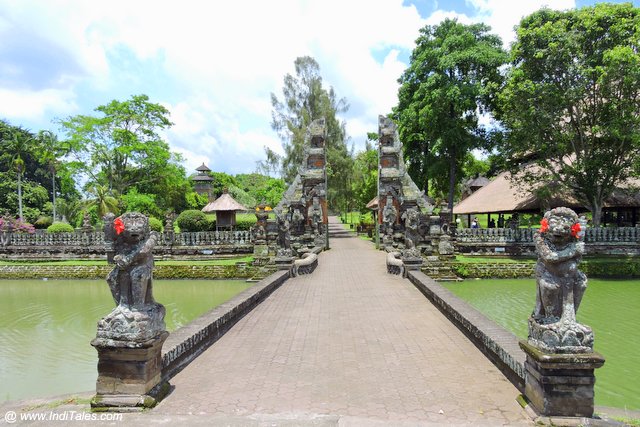
This is the royal temple of the island and that explains the vast expanse it covers with lawns and lotus ponds.
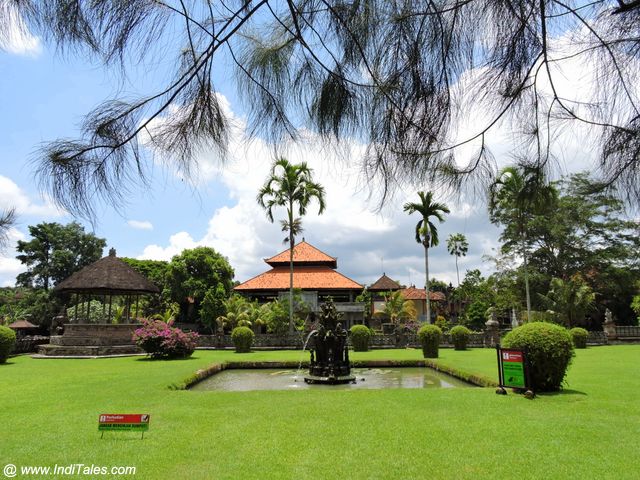
I walked into a pathway bifurcating a beautiful pond, duly guarded by the two guards whose ears wear fresh flowers. I passed by the typical Balinese temple gate leading to sprawling gardens. In the middle of the garden stood a small pond with a well-sculpted water fountain in the middle. A canopy sat in another corner. The well-maintained gardens gave an aura to the place. In the middle, a path led to a flight of steps that would take me to the temple surrounded by a boundary wall. I see the tower with a double canopy in one corner of the compound.
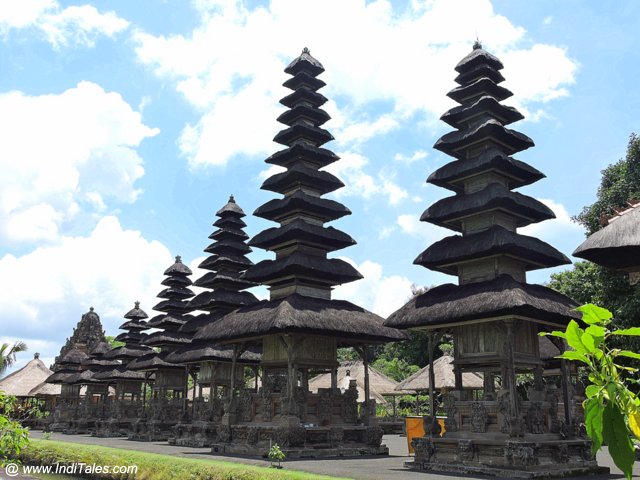
Once you take the steps, you come face to face with the tall temple structure. Be it steps or a door – it is always guarded by a set of two guards or Dwarpalas on either side. You are not allowed inside, but you can walk around the periphery of the temple.
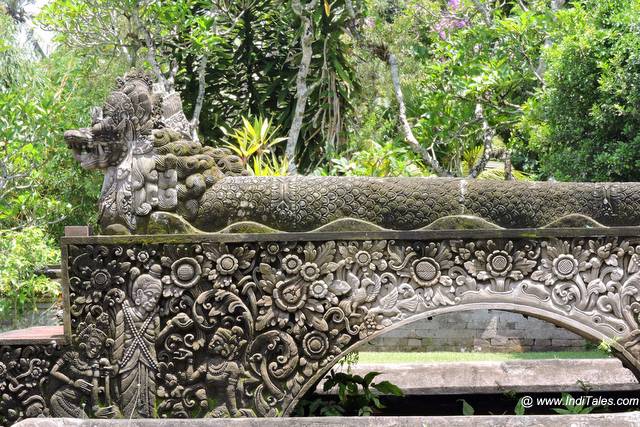
Behind the main gate, the pathway has an ornate balustrade. Its top is in the form of a snake. On the side, a relief shows a Sadhu surrounded by a man playing an instrument and a woman sitting on the floor in the midst of foliage.
Meru
You can see the many tall tiered structures called Meru surrounded by platforms around them. The main mandir is surrounded by a water moat. It probably indicates it is a water temple.

There are flat platforms that I assume are used for offerings. Smaller platforms have shrines on them. All of them have an impeccably trimmed thatched slanting roof on them. On top of these roofs is a thunderbolt an icon. There are smaller pillar-like shrines around these platforms.
I could see some well-defined sculptures there. But have no idea what they stand for and what their backstories are. A lot of them have wings and fine jewelry on them. If you know of them, I am all ears.
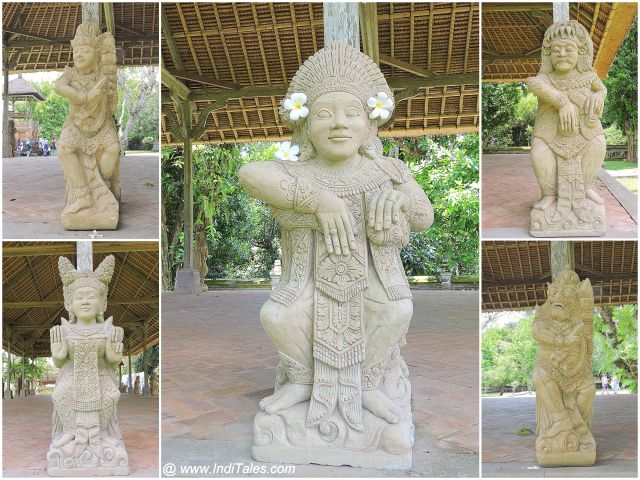
Pillared Pavillion
Outside is a large pillared pavilion that is surrounded by these images. I can only decipher Saraswati with her Veena. The rest of them are still a mystery to me.
Another similar pavilion had a cockfight scene depicted with horses standing on the side.
In a corner platform, I found a few paintings as a model depicting a fierce element. Due to the language gap, I could not gather the exact name but the formation indicates some spirit.
Pura Taman Ayun was the royal temple of the Mengwi dynasty that reigned till the late 19th CE. This indicates that the Subak system was well in use till 19th CE. This dates back to 17th CE but was renovated in 20th CE.
It is fairly large. Despite not entering, I spent an hour or so going around. And trying to make sense of the place. I wish there was a guided tour or a board explaining the various parts of the mandir – at least its water management system.
Tirta Empul – The most active Water Temple of Bali

Tirta Empul is the busiest and most active temple on the island. It is a huge complex with many things to see and observe.
At the entrance, there is a huge tree that is worshipped by making offerings at a platform around you. Again you can see it by walking around it. But you are not allowed to enter. Only local Hindus are allowed to enter.
Tirta Empul literally means Holy Spring. The temple dates back to the 10th CE. And is built around a spring that is the source of the Pakerisan River.
The main attraction here is the pool of water with water coming from many sprouts. There were queues of people standing behind each sprout for their turn to take a bath. Many others wait on the platform next to the pool. Each sprout has a symbol associated with it.
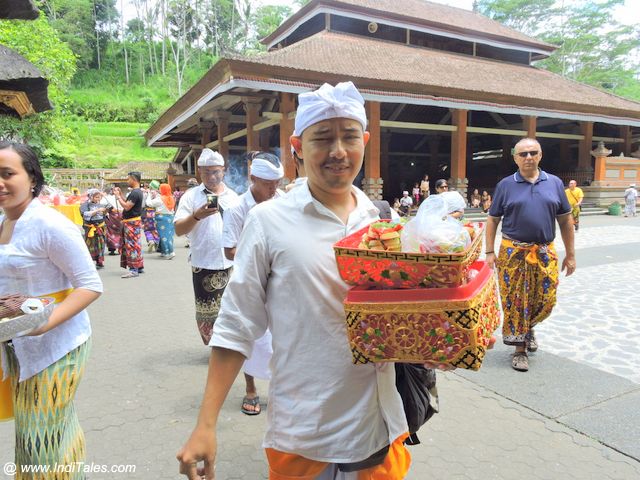
Offerings
Families carry a box and a Potli-like wrapping as offerings. Dressed in traditional attire with a rice tilak on their foreheads, they look beautiful – emanating the essence of their culture. Even the boxes they carry are aesthetically designed.
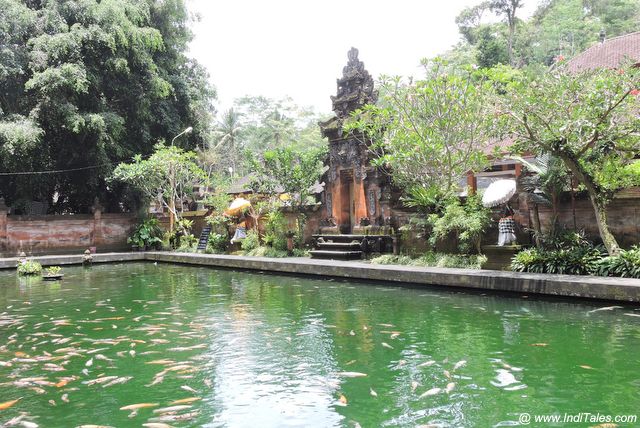
One side has a fish pond surrounded by a wall. People feed the fish and fish rush to the part where people are – talk of forming habits.
The main temple is full of platforms. Tirta Empul is the only place where I saw people making offerings on these platforms. They would make an offering. And then sit around the platform where a priest would perform some rituals for them. There were simple platforms where offerings were made. And there were ornately decorated platforms full of statues of deities.
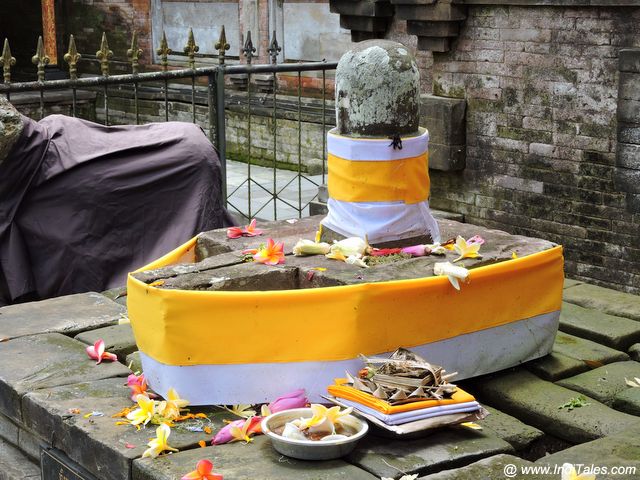
Tirta Empul is where I saw a proper Shivalinga. Wrapped in white and yellow cloth it looks well respected and well worshipped.
There is another pond behind with some shrines standing in the middle. This was the quieter part.
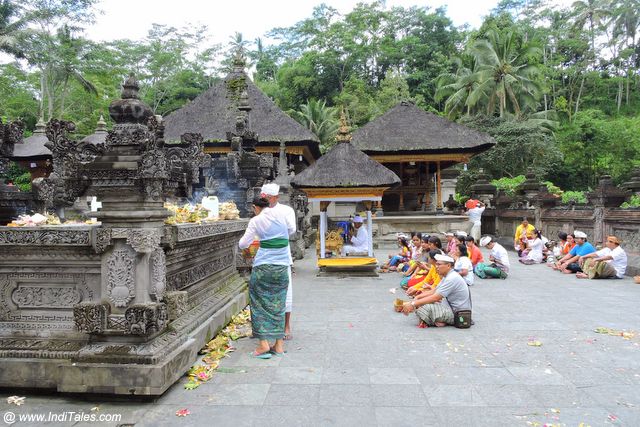
Outside, Banana Sellers offer you a free Banana. They ask you to taste it before you buy it. It was a unique thing that I found outside Tirta Empul.
There is a huge market outside where you can buy Bali Souvenirs.
Goa Gajah
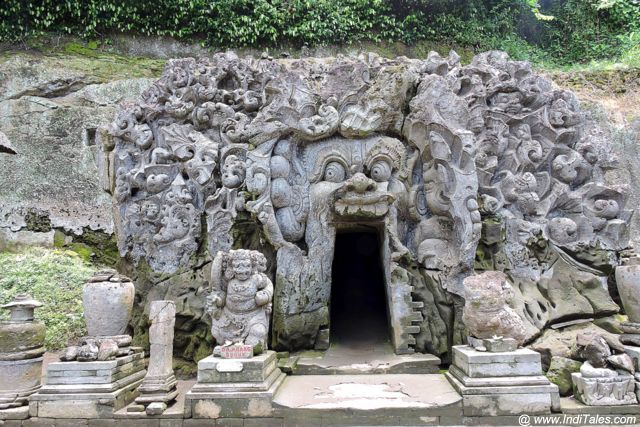
This is a cave temple with an extensively carved face. The face was thought to be that of an elephant (it does not look like one from any angle) so the cave got its name Goa Gajah. Goa in Balinese means Cave and Gajah in Sanskrit for Elephant.
At the entrance is a Water tank divided into two parts by a pathway. Each part of the tank has water coming from three stone figurines on the main wall. I assume there is a mechanism for the water to flow out as well.
The water tank is surrounded by Platforms that are used by visitors.
The face of the cave is impressive. Entering the cave is like entering the mouth of a dragon.
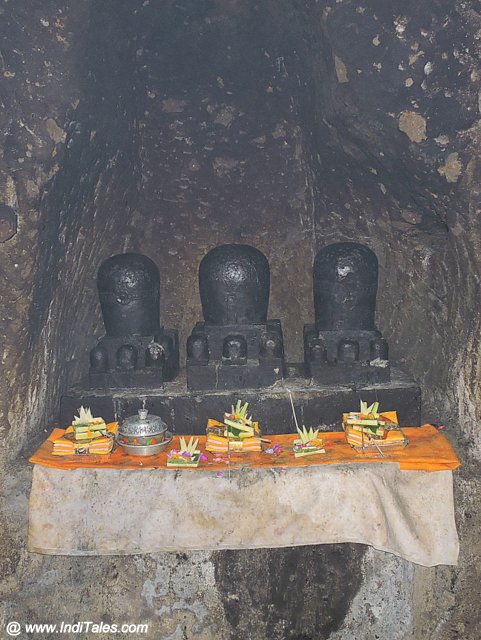
Inside the cave, two vestibules go on either side. The left side leads to an idol of Ganesha. The right one to the three Shivalingas. There are some empty niches – I assume there would have been some idols there sometime.
There are broken stone pots outside the cave.
It is a small cave temple, that you can see in 15-20 minutes. Goa Gajah did have a water tank outside that made me think it might be one to list.
This was my exploration of some of them. In search of the Subak System that really intrigued me.
I hope to go back and explore more there.
Read More
Recommend you read the following travel blog on places to visit Indonesia.
Pasir Timbul – Most Beautiful Island of Raja Ampat
Storytelling Ruins of Prambanan Temple, Java














Amazing and beautiful place . I want to be there a day . I love their temples strange structure !!
You must visit Bali and spend some time exploring its unique temples. I was told that these temples practice Vedic Era Hinduism which is very different from what we practice here in India.
this pictures and information tempted me to visit bali soon
history and subak system you mentioned is amazing
Mayuri – the traditional systems are incredible. They take care of everyone’s needs and not just their own. Bali temples have a beautiful architecture too.
I am absolutely in Love with Bali! lovely pics thanks for bringing back the memories of my trip to Bali 🙂
Glad you enjoyed the post, Madhulika. I so want to go back and explore it in detail.
Wow!! This is a very nice place .thank you so much.
Thanks Yasmeen, Glad you enjoy the IndiTales story on Bali Temples.
Hi there
Amazing post. The pictures are just fabulous. Made me fall for Bali. The architecture and the history, enough reason to pack my bags. 🙂
:-), Sure, pack your bags. Come back and tell us your experience of Bali.
What an amazing experience! The pictures really captured the architecture of the temples
Thanks Saidah.
Bali is such a gorgeous place. These temples are so stunning. I hope I can make it there to explore.
Amber, if you are visiting Bali, they are too difficult to explore.
what a lovely and exotic destination! I understand it’s difficult to explore a place like Bali but men, would that be a lifelong dream! I would love to visit a hindu temple!
Chelf, I found Bali quite easy to explore. People are simple and friendly and you would find a Hindu temple literally on every street.
Wow those temples look amazing! I´m trying to visit Bali since for ever but till not I didn’t make it…
Stefani – now that you have said it, Bali trip will happen soon enough. Mark my words 🙂
Looks like a pretty place with rich history. Pretty architecture and well maintained area.
Natasha, Bali has such a unique architecture. Once you have been there, you can identify it among million other styles. Most temples are very well maintained – and treated with a lot of respect.
Wow! I always thought Bali has beautiful beaches but never knew so much about it. The temples are beautiful. Thanks for sharing the info.
Deepa – Bali temples are not just beautiful but they work on using the water in a sensible way. There is lot we can learn from them.
This looks amazing. The sculptures are gorgeous .Would love to visit Bali.Didn’t know about the scrict dress code at he temple.
Amrita – Bali is one place you must visit once in your life time.
Oh yes will do
OMG Bali is SO beautiful! It seems to be the one spot these days that everyone keeps mentioning. I really need to save my pennies so I can visit here.
Nadalie – I heard of Bali for the longest time before it happened for me. I have to go back to see it in more detail.
The sculpture and architecture looks so unique and different from what we generally see here at the Indian temples, especially the entrance of the royal temple. Subak water management system sounds amazing and hope we implement it here too.
Jahnavi – The Hinduism, as it is practiced in Bali is very different from the one we practice in India. In my opinion, they follow a more Vedic Hinduism, but then I am not the expert.
What a nice and gergeous destination to visit. One must go to Bali. Sumak system is amazing. Smart mind they have and temples are perfect also. Thanks for sharing this post.
Glad you liked it Balayi.
Nice picture Collection. Love to read
Thanks For writing This Wonderful Blog
NICE
Thank you! Cool destination. I’ll consider it as my next trip.